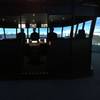Clean Air Engineering-Maritime (CAEM)'s emissions treatment system for ocean-going vessels has been approved by the California Air Resources Board, giving operators of container vessels a second option for complying with the state’s strict emissions requirements for vessels at berth.
Technology, developed at the port of Los Angeles, captures 90% of 'at-berth' emissions.
CAEM announced it has received CARB approval for the first commercially ready ship emissions capturing system called the Maritime Emissions Treatment System (METS).
The METS-1 is CAEM’s first-generation system. It is mounted and deployed from a barge that is positioned alongside ships berthed at the Port of Los Angeles. The system is positioned over vessels’ smoke stacks and captures and treats more than 90 percent of particulate (PM), NOx, SO2, and related diesel pollutants emitted.
The proprietary treatment technology was developed in collaboration with Tri-Mer Corporation of Owosso, Mich., the world’s largest supplier of catalytic ceramic filter systems.
METS is the first CARB-approved alternative to “plugging in” to shore-side power -- also called cold-ironing or Alternative Maritime Power -- which is the current standard for meeting California’s “Airborne Toxic Control Measure for Auxiliary Diesel Engines Operated on Ocean-Going Vessels At-Berth in a California Port” (At-Berth) regulation.
Since January 1, 2014, vessel operators not complying with the regulation run the risk of not meeting these emissions standards and being hit with significant fines.
“The METS-1 will have an immediate, direct and positive impact on the communities surrounding the Port of Los Angeles and Long Beach,” said Nick Tonsich, CAEM principal and San Pedro native. “In the long term, given the fact that there are so many ships in the world’s fleet without cold-ironing capability, the METS system could have a profound impact on the entire shipping industry and our global environment.”
“In recent years, we have supported development of this technology through our Technology Advancement Program,” said Port of Los Angeles Executive Director Gene Seroka. “With CARB verification approval, this is now a solution that other ports can consider to lower vessel emissions in their harbors and surrounding communities.”
The Port of Los Angeles has been a leader in development of technologies to control at-berth emissions. More than a decade ago, the Port of Los Angeles pioneered development of Alternative Maritime Power (AMP) for cargo ships.
Today, 24 berths at the Port of Los Angeles are equipped for shore power, the most of any port in the world. AMPing at berth eliminates upwards of a ton of NOx emissions per vessel per 24-hour period. Similar results have been demonstrated by the new METS alternative.













